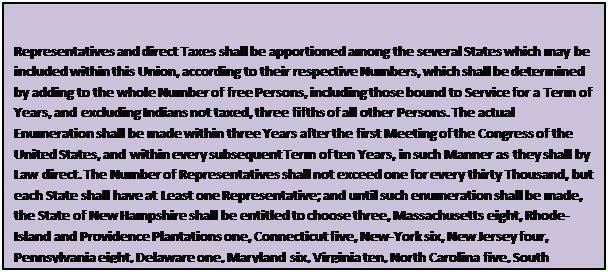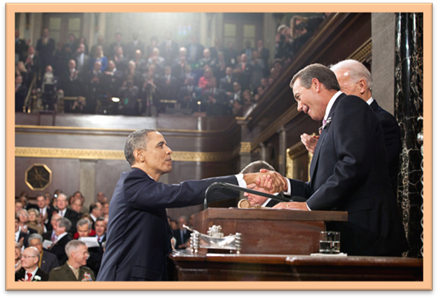CONGRESS
IN ACTION
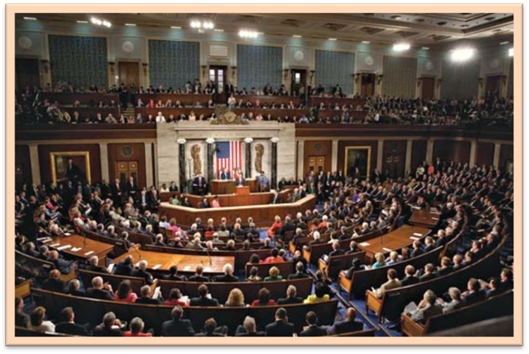
A Joint Session
of Congress in the House of Representatives
Unit Overview
The Preamble or introduction to the Constitution
expresses the objectives of the document.
It clarifies the intentions of the Founding Fathers, states the
Constitution’s purposes and stresses what the delegates of the Constitutional
Convention hope to achieve.
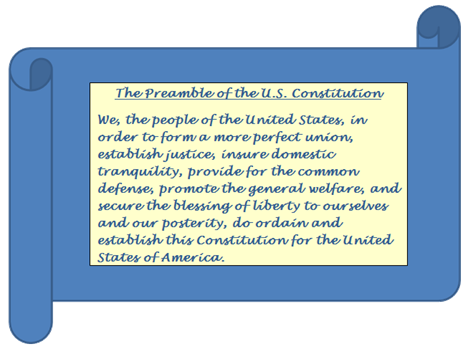
The Preamble is followed by series of Articles or
sections that define the United States plan for government. It is no accident that Article I discusses
the functions and responsibilities of Congress.
The Founding Fathers believed that the legislative branch should play a
key role in the leadership of the new nation.
However, like the executive and judicial branches, its powers were
carefully checked and limited. What are
the qualifications for the members of Congress?
What powers do they have? Are
there any “perks” to the job? Let’s see!
![]() Go to Question 1.
Go to Question 1.
The House and the Senate
The United States Congress is composed of the House of Representatives or lower house and the
Senate or upper house. Both bodies
have their own chambers in the Capitol but
meet together for joint sessions in the House of Representatives on
occasion. Both areas have balconies
where private citizens can view Congress in action. Senators and Representatives are both part of
the legislative branch of government but have different requirements for
membership and responsibilities as indicated on the chart below.
|
|
Senate |
House of
Representatives |
|
Qualifications |
At least 30 years of age U.S. citizen for 9 years Live in the state represented |
At least 25 years of age U.S. citizen for 7 years Live in the state represented |
|
Size |
100 members Two from each state Elected by the entire state |
435 members Dependent on population Elected by their district |
|
Length of Term |
6 years |
2 years |
|
Constituents |
Represents the citizens of the entire state. |
Represents the citizens of a district within the state |
The U.S. Capitol in Washington D.C. is a fascinating
place to visit. Take a virtual tour by clicking
on the link below.
http://uschscapitolhistory.uschs.org/tour/02.htm
Membership in the Senate is based on the principle
of equality for all states regardless of size. Each state is represented by two
Senators. Originally, the Constitution
stipulated that Senators were to be appointed by state legislatures, but an
amendment in 1913 allowed their direct election and strengthened the principle
of popular sovereignty. The framers of
the Constitution thought it was important that the Senate maintain some degree
of continuity and provided for this.
One-third of the Senate comes up for reelection every two years; this
gives a continuum of at least two-thirds at all times.
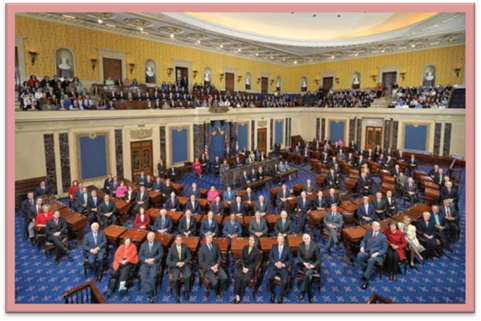
U.S.
Capitol: Senate Chamber
Unlike the Senate, membership in the House of
Representatives is based on population with every state having at least one Representative.
The Constitution explains how Representatives are to be apportioned in Article
1, Section 2, Clause 3. The Founding Fathers realized that a
reasonably accurate count of the people of the United States was necessary if
this concept was going to work. They
required a census “…within every subsequent term of ten years.” However, as the country grew, there was a
concern that the House membership would become too large and too
inefficient. Therefore, Congress set the
number of Representatives at 435 in 1911.
Today, each seat in the House represents an average of 610,000
people. Every state is divided into
districts, and a Representative is chosen from each one. When states gain or lose people, redistricting becomes necessary. If a state’s population increases or
decreases, the boundaries of districts change.
Sometimes political parties or special interest groups try to manipulate
the boundaries to favor a particular party or cause. Elbridge Gerry was influential in doing
exactly that in 1812. The district’s
shape so resembled a salamander that people began to call it a “Gerry-mander”. Similar
attempts to change the composition of voting districts are still known gerrymandering.
|
U.S. Constitution: Article 1, Section 2, Clause 3 |
|
|
To read Article 1 of the Constitution in its
entirety, click on the link below or access the PDF
http://ratify.constitutioncenter.org/constitution/details_explanation.php?link=010&const=01_art_01
![]() Go to Questions 2 through 6.
Go to Questions 2 through 6.
The Power of Congress
The Constitution gives the Congress the power to
carry out its primary function, which is to pass laws. Laws begin in the form of bills or
suggestions for laws. They are written,
discussed and debated by members of both the House and the Senate. Bills dealing with money must be introduced
in the House of Representatives. All
other bills may begin either in the House or in the Senate. Each bill must be approved in the exact same
form by both houses of Congress. It only
becomes a law if it successfully survives a rigorous series of obstacles. Since it is actually easier to defeat a bill
than to pass it, those opposing the legislation have the advantage. Winning a majority vote at each stage of the
process almost always requires compromise and consensus building. This requires negotiation, compromise and
consensus building among Congressmen.
The Constitution gives Congress a broad-based list of enumerated or expressed powers in
Article 1 Section 8. They include the
authority to declare war, to raise armies, to coin money and to regulate
trade. The link below or the PDF File
offers a complete list of the enumerated powers as specified by the
Constitution.
http://ratify.constitutioncenter.org/constitution/details_explanation.php?link=010&const=01_art_01
Clause 18, known as the elastic clause, gives Congress the flexibility to make laws that are “…necessary and proper” for efficient government. This gave the legislative branch certain implied powers that were not named in the Constitution but enabled Congress to handle circumstances that the Founding Fathers could not foresee. Congress has stretched the elastic clause many times throughout the course of American history to cover significant accomplishments such as the establishment of the Bank of the United States and the purchase of the Louisiana Territory.
|
U.S.
Constitution: Article1, Section 8,
Clause 18 |
|
To make all Laws which shall be necessary and proper
for carrying into Execution the foregoing Powers, and all other Powers vested by
this Constitution in the Government of the United States, or in any Department or Officer
thereof. |
![]() The Process of Making Laws (02:29)
The Process of Making Laws (02:29)
Passing laws gives Congress a great deal of
authority and influence over American government. However, there are ways to keep this
Congressional power from being abused.
Once a bill is passed by both houses, it is sent to the President. If he chooses to sign it, the bill becomes a
law on January 1 of the following year.
The President can also veto the bill and send it back to Congress. The bill can become law in spite of the veto
if Congress chooses to override it by a 2/3 vote. The judicial branch of the federal government
can also check the law-making power of Congress by declaring laws
unconstitutional. The Constitution
itself also forbids Congress to pass laws that violate civil rights, confer titles
of nobility or interfere with those areas of control reserved for the states.
![[Barack Obama signs the Patient Protection and Affordable Care Act at the White House, March 23, 2010]](SSUSGU03_Congress_Action_image013.png)
President
Barack Obama Signing a Bill into Law
The Constitution grants certain exclusive powers to
both the House and the Senate. For
example, revenue bills, which deal with funding and taxation, must begin in the
House of Representatives. The House also
has the authority to charge or impeach
an elected official, including the President, with a simple majority vote. It is then the responsibility of the Senate
to try the impeached individual, but a 2/3 vote is required for removal from
office. The Senate confirms major
Presidential appointments and approves treaties made by the President.
![]() Go to Questions 7 through 12.
Go to Questions 7 through 12.
Leadership in Congress
Formality demands that each house of Congress choose
its own leaders by a vote of the membership.
However, this decision is really made informally by America’s strongest
political parties, the Republicans and the Democrats. Election results determine the majority party
and the minority party. Although not all
Congressmen vote along party lines, a majority in Congress helps a political
party to achieve its agenda. It also
enables the party to put its members in key positions of leadership.
Ø Speaker of the House: The Speaker of the House is the most powerful
member of the House of Representatives.
The Speaker is a member of the majority party but is usually not
considered too extreme in his position on most issues. This promotes the compromise and consensus
building necessary to reach agreement in Congress. The Speaker has many powers, but one of the
most significant allows him/her to preside over House debates on proposed
bills. This permits the Speaker to
decide which Representatives can address the House from the floor and for how
long.
Ø President of the Senate: The Vice President of the United States
serves as president of the Senate but has little authority here. However, when Senators act on a piece of
legislation, he does vote if there is a tie.
Ø President Pro Tempore:
Since the Vice President’s other duties often make it impossible for him
to be available, the president pro
tempore (temporary) presides over the Senate. This position is held by a high-ranking
Senator from the majority party.
Although it carries a great deal of prestige, it does not compare in
importance to the Speaker of the House.
Ø Majority and Minority Leaders: Both the House and Senate select members of
the majority and minority parties to serve as the strategists and spokespersons
for their respective groups. Majority and minority leaders are often chosen
based on their leadership style and seniority.
Ø Majority and Minority Whips: The term “whip” is borrowed from the British
fox-hunting tradition. The “whipper in” was responsible for keeping the hounds together
and on target during a hunt. Majority
and minority whips in the House and Senate try to keep the members of their
respective parties together and on target with legislation. They make sure party members are present for
important votes and mobilize support for specific issues.
John Boehner Serving as Speaker of the House
![]() Go to Questions 13 and 14.
Go to Questions 13 and 14.
Committees in Congress
Because both houses of Congress are composed of
large groups of people from various regions, backgrounds and constituencies, a
system of committees is used to help carry out the work. Ranging in size from ten to sixty members, standing or permanent committees cover
areas such as appropriations, the armed forces and foreign relations. Since these are broad topics, subcommittees
are formed to address specific aspects.
Other committees, known as select
committees, are organized for a single purpose and for a limited time. They are often a response to a particular
event such as a natural disaster or a terrorist attack. Conference
committees also play significant roles in Congress. They are composed of members of both houses
and reconcile different versions of the same bill. Once the members of these committees reach an
agreement, the bill is returned to both houses of Congress for final
consideration.

Armed Services
Committee touring the USS Theodore Roosevelt
Committee assignments are based on a number of
factors. The majority party decides the ratio
of Democrats to Republicans on each committee.
Although the number should reflect the overall party membership in each
house, the majority party usually gives itself a few extra seats on important
committees. Aside from their political
party, Senators and Representatives may be placed on committees due to their
seniority, areas of expertise or geographic sections of the country. Each committee is chaired by a Congressional
member of the majority party. Committees
and subcommittees often need more information when they are considering
important issues. As a result, they
often hold public hearings and request information from expert witnesses,
concerned citizens and other government officials.
![]() Go to Questions 15 and 16.
Go to Questions 15 and 16.
Congressional Benefits
Even though Senators and Representatives work on
behalf of their states, they are paid through the national treasury. Therefore, they determine their own salaries
and benefits. When Congress votes itself
a pay raise, however, the increase cannot take effect until after the next
election. The first Congressmen, who met
in 1789, were paid $6.00 per day for their service. Those who serve in Congress today earn
$165,200 as a base salary. In addition,
members also receive a number of services and benefits. For example, Senators and Representatives
receive expense accounts to pay for supplies and staff. They also are provided with office space near
the Capitol along with travel expenses and healthcare. The franking
privilege permits the free use of the postal service.
Congressmen are also entitled to certain legal
rights the average citizen does not have.
Under a constitutionally granted privilege called congressional immunity, members cannot be arrested while they are
attending sessions of Congress or while traveling to and from them. Although they can be tried and convicted of
criminal crimes, they are exempt from some civil suits as well as jury duty and
minor traffic violations. When speaking
in Congress, Senators and Representatives cannot be sued for slander or
libel. Any remarks or speeches printed
in the Congressional Record, a daily journal of the activities of
Congress, are also exempt from these charges.

Congressional Record in Printed and Electronic Form
Citizens are quick to note when these privileges are
being abused. Members of Congress have made
an effort to prevent their colleagues from taking advantage of their
positions. The Senate and the House of
Representatives have adopted written codes
of ethics. These consist of rules
for conduct and guidelines for financial dealings. According to the Constitution, each house of
Congress may punish its members for “disorderly behavior” and expel any
offenders with a 2/3 vote.
![]() Go to Questions 17 and 18.
Go to Questions 17 and 18.
What’s Next?
The legislative branch of government, composed of
the Senate and the House of Representatives, is a formidable force in American
government. The Constitution gives
Congress an extensive list of both expressed and implied powers but provides
specific limits in the form of checks and balances. As a result, there are times when the
President and the Supreme Court challenge the authority of Congress. The role of the presidency has grown
extensively since the Constitution was written.
The media, political parties and the need for specific policies have
combined to make the
President of the United States one of the most powerful individuals on
earth. Before we look at this office in
detail, review the terms and ideas from Unit 3.
![]() Go to Questions 19 through 28.
Go to Questions 19 through 28.

Below are additional educational resources and activities for this unit.
